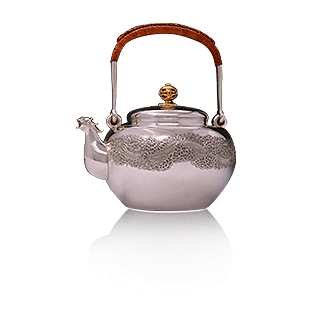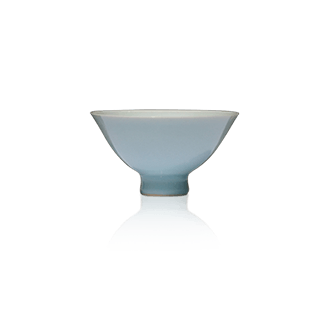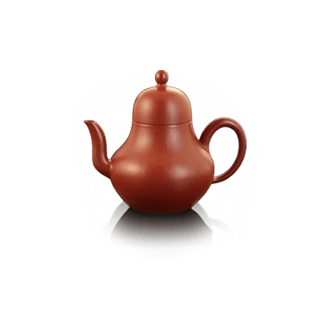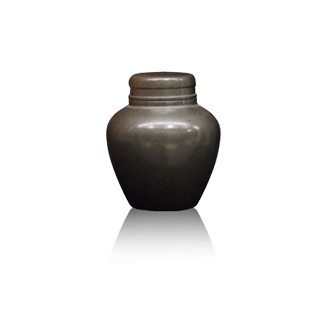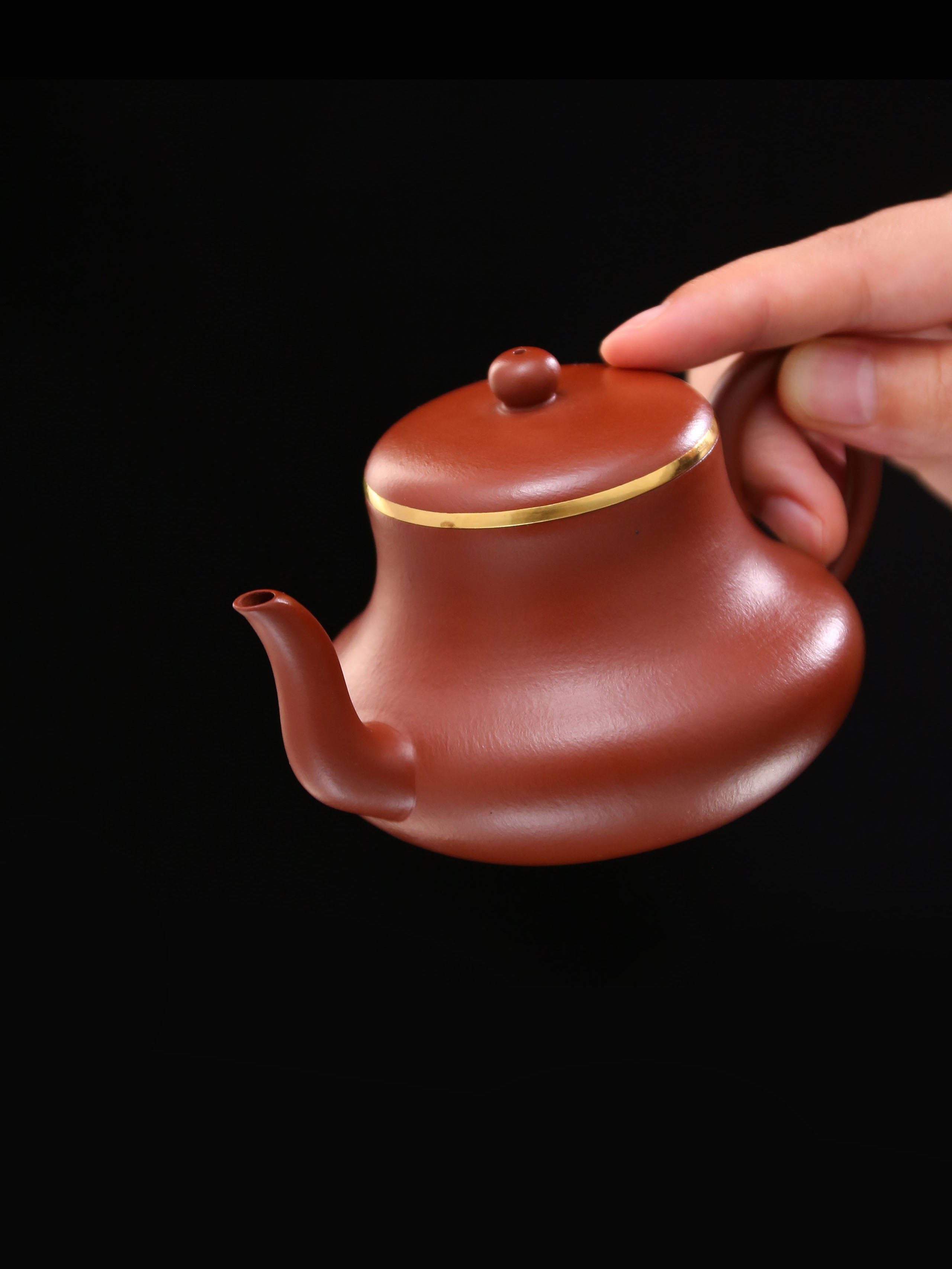




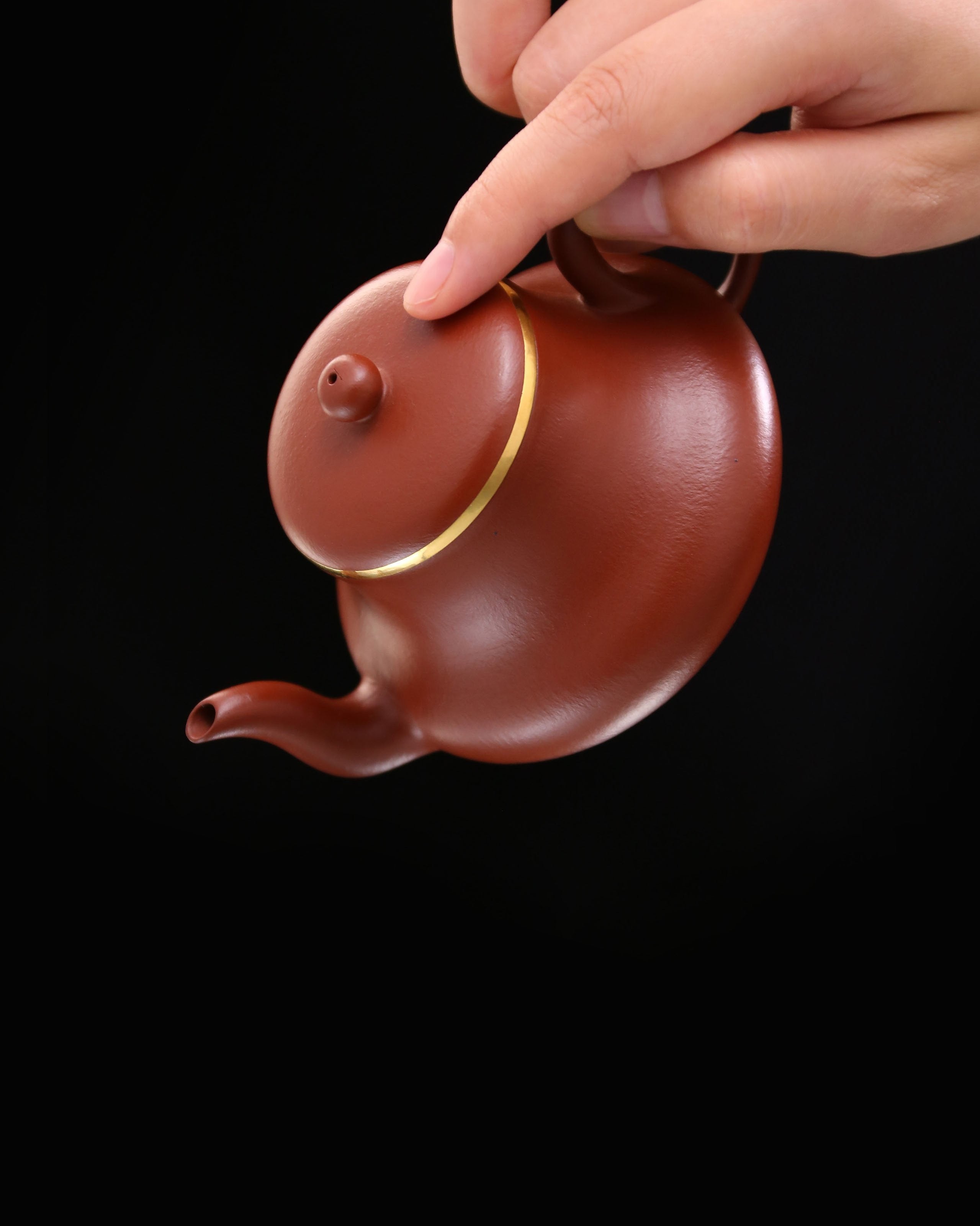
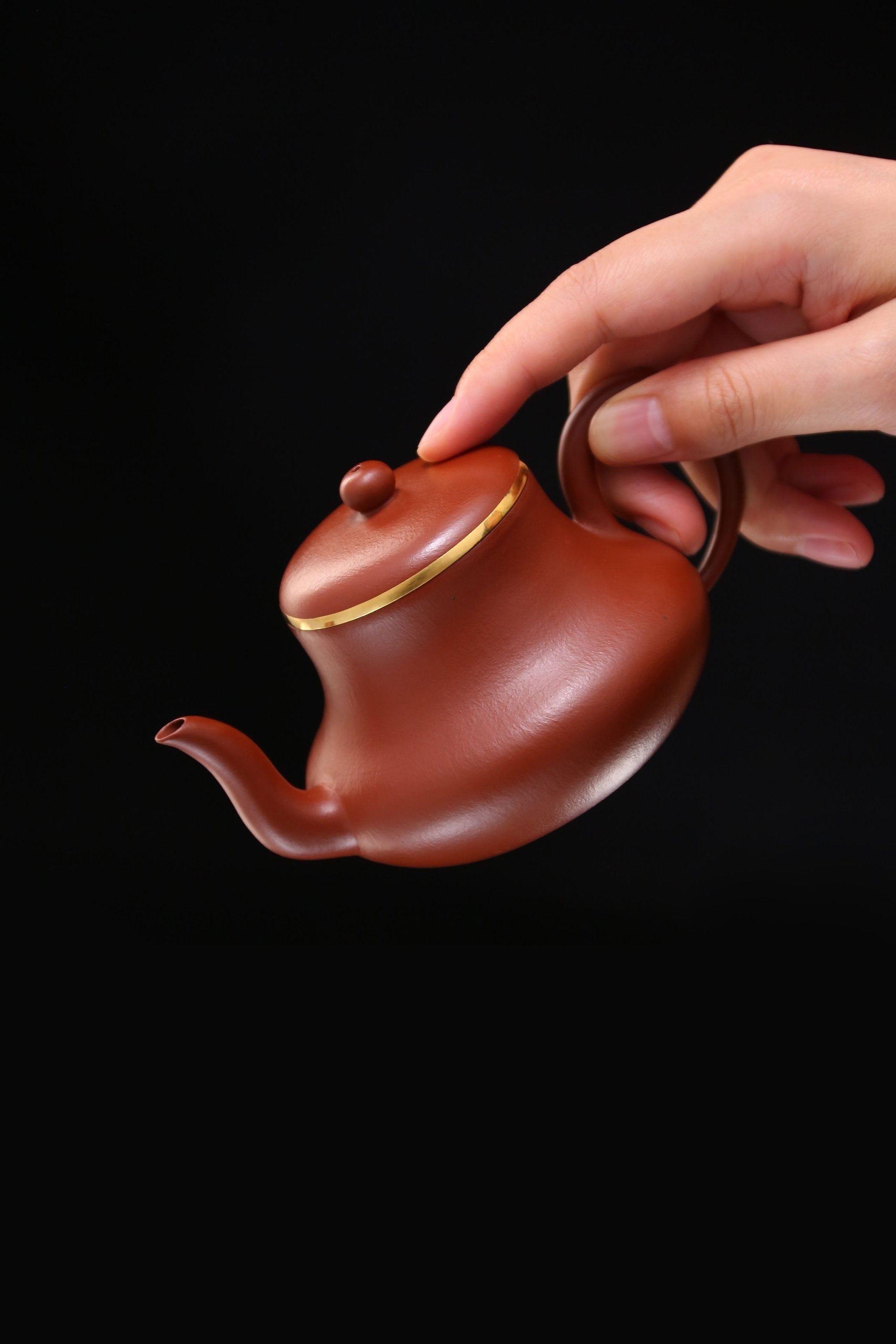
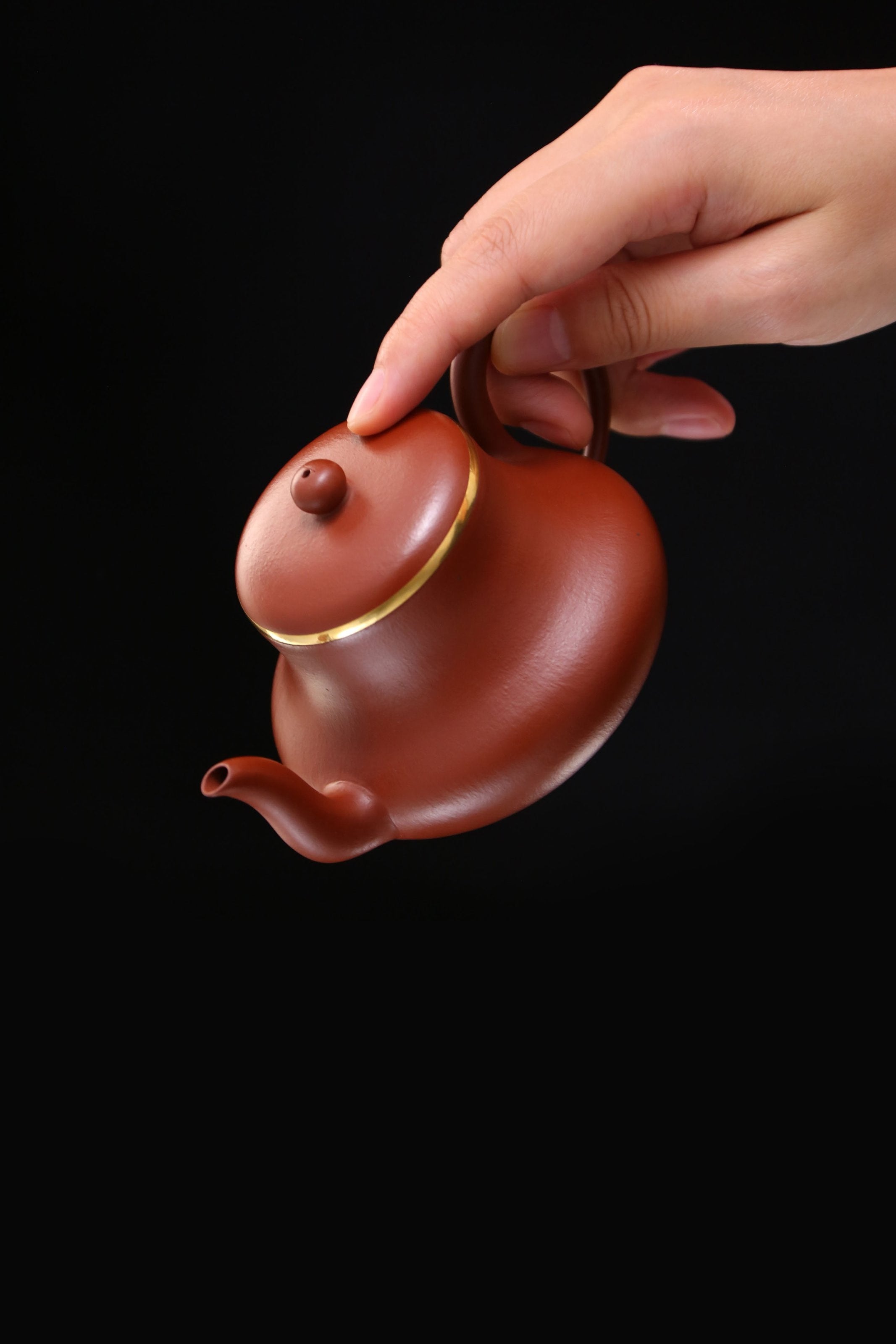

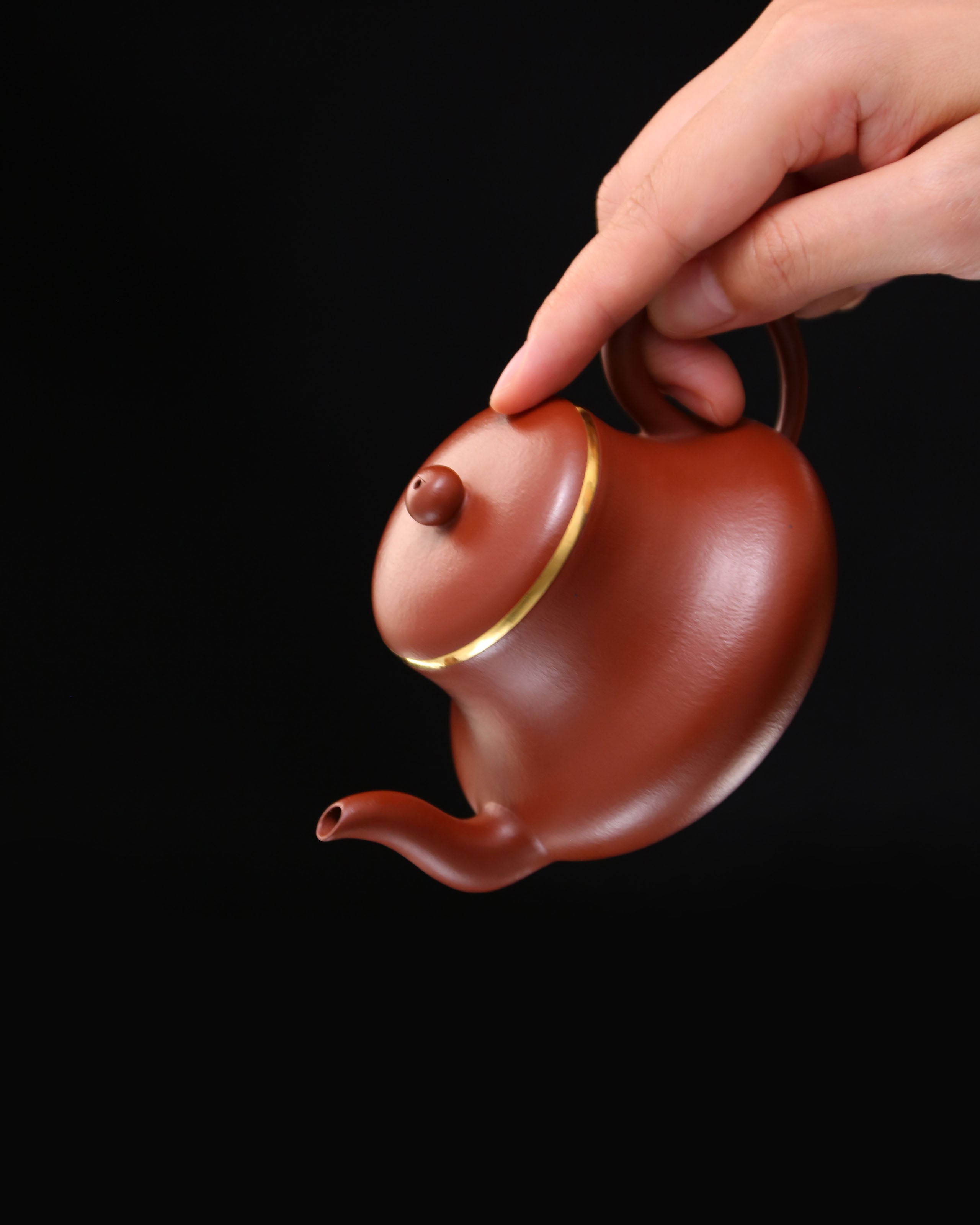




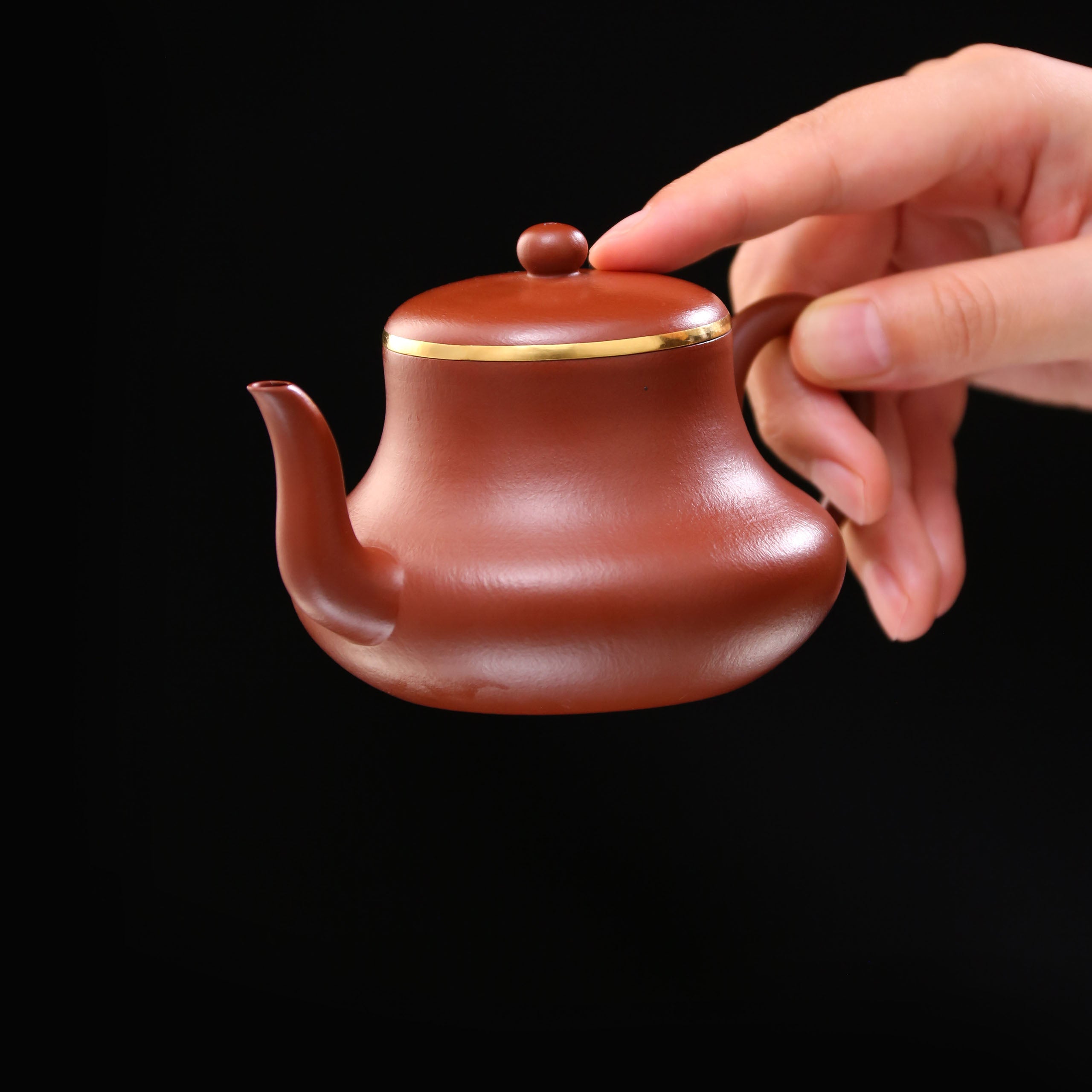
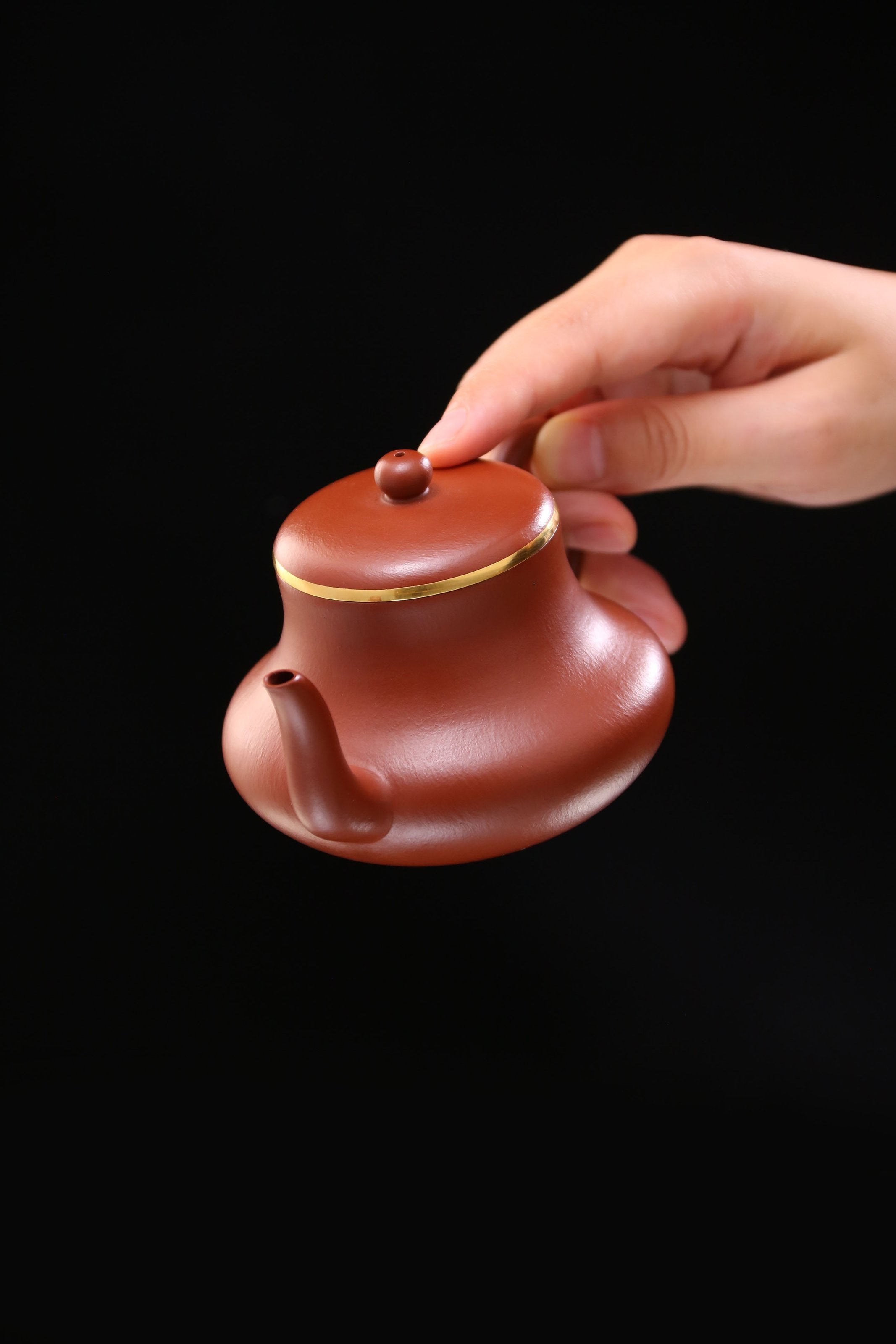


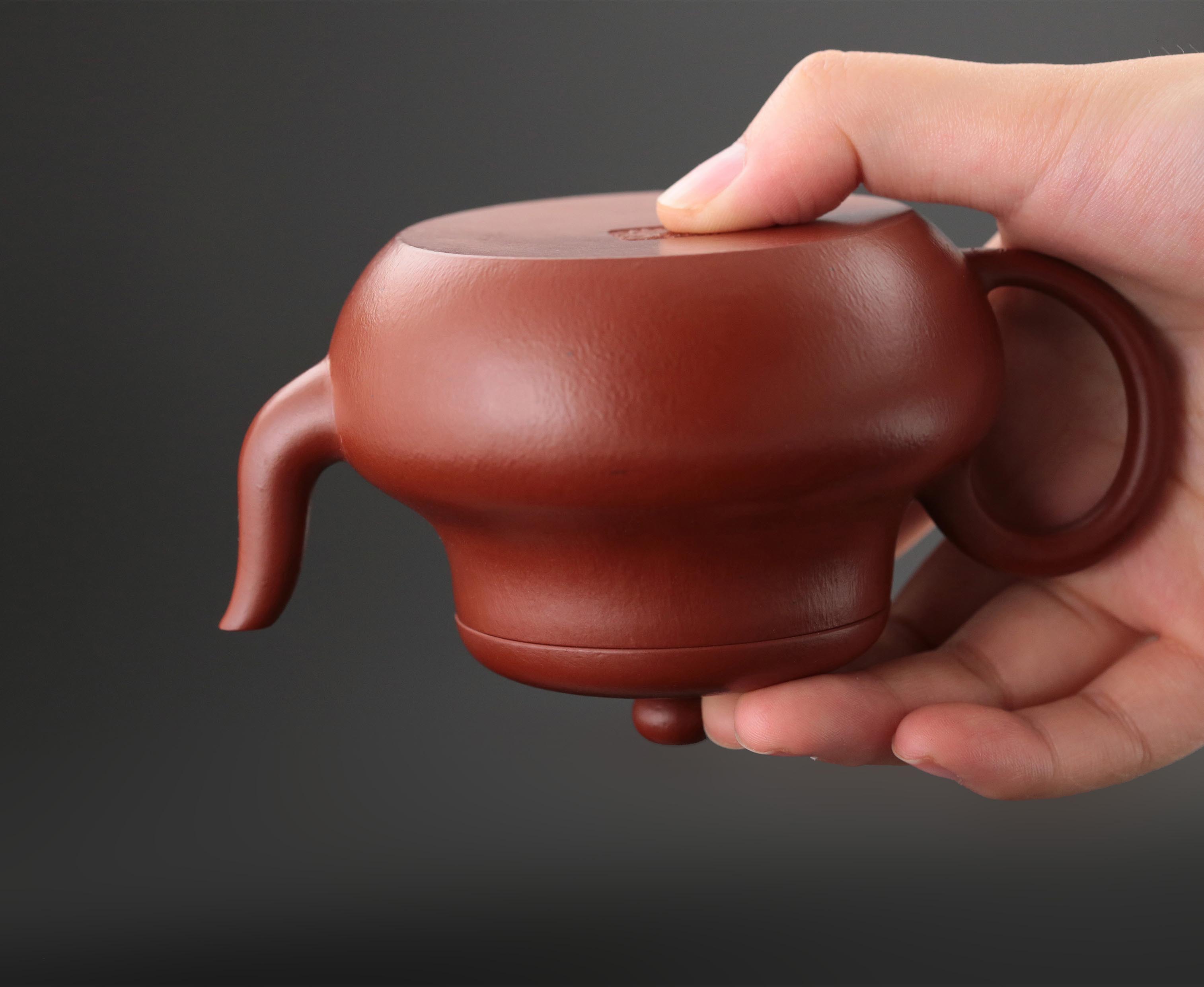
Junde Teapot - Zhao Zhuang Old Zhu Ni Clay





















Junde Teapot - Zhao Zhuang Old Zhu Ni Clay
Junde Teapot - Zhao Zhuang Old Zhu Ni Clay
Material: Zhao Zhuang Old Zhu Ni (Red Clay) Author: Qin Xun Capacity: 200ml
Specifications: Length 12.5cm, Width 9cm, Height 7cm
Inner diameter: 5cm
Made from the old Zhu clay of Zhaozhuang Mountain, it is extremely rare and only seen on the market. This is an ancient and renowned clay.
The vermilion is a subtle, understated red, a stable color, dense yet not slippery, with beautiful flowing patterns. It has shrunk by about 28-30%, giving the vermilion clay its unique skin-like texture of slight wrinkles. The old clay has been aged for a long time, making it warm and smooth. The iron content of the original ore forms black spots, and a few drops sprinkled casually evoke a sense of weathered history.
It sits there quietly and unassumingly, its ancient charm growing stronger with each use. When hot water is poured over it, it immediately reveals a delicate, vibrant red color, and a fleeting purple glow appears on its surface.
Appreciation
Qin Xun (1980b.), a craft artist, young ceramic artist, and member of the International Zisha Association, specializes in handmade Zhu Ni clay works.
Zhu Ni clay is selective in its maker, and the maker is selective in its clay; most Zhu Ni masters will not make tea if they change the clay. Zhu Ni has a low firing rate and a small tolerance for kiln temperature; the clay has its own properties and should be made in accordance with nature. Therefore, compared to the dazzling brilliance of other Zisha teapots, Zhu Ni teapots have been passed down through the ages for their unassuming, simple shapes and minimalist lines, their unique traditional charm enduring through time!
Master Qin Xun was obsessed with making Zhu Ni teapots throughout his life, and his grasp of the spirit and charm of traditional shapes was unparalleled!
The "Jun De" teapot is named after the potter Zhang Junde. It has a short, pear-shaped body with a three-bend spout pointing upwards, a ring handle, and a round beaded knob on the lid. Made from old Zhu Ni clay from Zhaozhuang Mountain, it is extremely rare. The clay is a subtle, vibrant red, rich yet not gaudy, dense yet not slippery, with beautiful flowing patterns. It has shrunk by approximately 28-30%, giving it a unique, slightly wrinkled texture. The old clay has been aged for a long time, resulting in a warm and smooth texture. The iron content of the original ore forms black spots, slightly scattered, giving it a weathered and aged feel. The bottom bears the inscription "Handmade by Qin Xun".
Zhu Ni clay has a low firing rate and a small tolerance for kiln temperature. The clay itself has its own properties and should be fired in accordance with nature. Therefore, compared with the dazzling colors of other Zisha clays, Zhu Ni teapots have been passed down from ancient times for their unassuming and plain shapes, minimalist and restrained lines, and unique traditional style.
Analysis of Zhao Zhuang Old Zhu Ni
Zhao Zhuang Lao Zhu Ni (Old Red Clay) is a highly representative type of Zhu Ni (red clay) in Yixing Zisha (purple clay) teapots. It is renowned for its long aging process and scarcity of mineral resources, and is especially sought after by enthusiasts of traditional Gongfu teaware. The following analysis examines its characteristics and value from multiple perspectives:
I. Origin and Mineral Source
Geographical location : It originates from Zhaozhuang Mountain in Dingshu Town, Yixing (originally part of the Huanglong Mountain range). The mineral layer is distributed on the shallow surface of the mountain. Mining mainly took place from the late Qing Dynasty to the Republic of China period. The mine was basically closed after the 1980s.
Mineral characteristics :
The ore is yellowish-brown, and the cross-section contains light yellow and ochre-red bands, with a small amount of speckled black iron.
The ore is hard and needs to be exposed to the elements for several months before it can be crushed and refined into clay. It is usually aged for more than 10 years and is called "old Zhu Ni".
II. Characteristics of Clay
Physical performance
Shrinkage rate : The firing shrinkage rate is about 20%-25%, which is slightly lower than that of Zhu Ni clay from small coal kilns, but the body of the pot is still prone to fine "earthworm patterns" and wavy marks on the edge of the lid.
Color : Raw clay is orange-yellow, turning into a bright orange-red (commonly known as "cherry red") after high-temperature firing. With long-term use, it develops a deep red patina and exhibits an agate-like luster.
Granular texture : The clay contains extremely fine mica particles, giving the finished teapot a feel like a baby's skin, and a "golden sand" effect can be seen under light.
chemical properties
It is mainly composed of kaolin and hematite, with a small amount of quartz and mica. The iron content is about 7%-10%. After firing, it has high density and air permeability that is weaker than that of purple clay but better than that of ordinary red clay.
III. Technological Challenges
Shaping Challenge : The clay is highly adhesive and must be shaped entirely by hand. Plaster molds should be avoided (as they tend to stick and crack).
Firing risks : The kiln temperature needs to be precisely controlled between 1060℃ and 1100℃. If the temperature rises too quickly, it is easy to "crack"; if the temperature drops too slowly, it is easy to deform.
Thin-walled control : Zhao Zhuang Lao Zhu Ni thin-walled teapots (with a wall thickness of less than 1.5mm) are top-level craftsmanship, requiring artisans to have a masterful control over the properties of the clay.
IV. Key Points for Identification
Characteristics of genuine products
Shrinkage texture : The folds on the pot body are naturally distributed and do not repeat irregularly (the texture of slip-cast imitations is mechanical and rigid).
The sound when tapped is crisp and metallic, with a high and short pitch, unlike the dull sound of chemical mud.
Water absorption : When water is poured onto the teapot, it quickly absorbs and diffuses the water, while fake Zhu Ni (made with added glass water) will cause water droplets to condense and be difficult to absorb.
Common methods of counterfeiting
Dyed mud : Ordinary red mud is mixed with iron oxide powder to make a bright red color that is glaring, but the color fades after soaking.
Applying slurry : Spraying red clay slurry onto the surface of low-grade clay, the cross-section shows color layering.
V. Applicable Tea Types
Highly aromatic oolong teas (such as Phoenix Dancong and Tieguanyin): The teapot has a strong aroma-concentrating effect, bringing out the floral and fruity aromas in the tea.
Aged Pu-erh (ripe Pu-erh) : Absorbs impurities and enhances its mellow taste.
Black tea (such as Lapsang Souchong): Enhances the sweetness of the tea soup and avoids sourness and astringency.
VI. Scarcity
The Zhaozhuang mining area has been closed for nearly 40 years. Most of the existing old clay is stored in private collections, and less than 3% is circulating in the market.
Teapots made from "old clay" that has been aged for over 20 years will have a more stable color after firing, and their price can be 2-3 times that of a new teapot of the same type.
In practice, it has been found that people's perception of the value of Zisha art often contains a fundamental misconception: people habitually attribute the high value of Zisha ware to the rarity of the clay, but in reality, its essence lies in the craftsmanship and wisdom poured into it by the artisans. Looking at the Yixing Zisha craft system, each master potter cultivates their own "clay memory bank" through long-term practice—these clays, nurtured over many years (especially Zhu Ni), remain unmoved even when offered exorbitant prices, because they embody the artisan's profound understanding of the clay's properties and firing techniques. It should be understood that while high-quality original ore clay is rare, its cost accounts for only one or two-tenths of the cost of fine Zisha ware. What truly constitutes the core value are the countless patting marks and meticulous needlework hidden within the lines of the vessel's shape.
In contrast, the production logic of low-end industrially manufactured teaware completely deviates from the essence of Zisha (purple clay) ware: mass production is achieved through mechanical stamping, visual impact is enhanced by chemical dyeing, a false luster is created through mechanical polishing, and hand-casting techniques are used to eliminate traces of handcrafting. While these products cater to the price expectations of the mass consumer market, they completely dissolve the true value of Zisha ware as a timeless art form—just as traditional hand-brewed wine and blended beverages, though both liquids, carry entirely different cultural genes.
Material: Zhao Zhuang Old Zhu Ni (Red Clay) Author: Qin Xun Capacity: 200ml
Specifications: Length 12.5cm, Width 9cm, Height 7cm
Inner diameter: 5cm
Made from the old Zhu clay of Zhaozhuang Mountain, it is extremely rare and only seen on the market. This is an ancient and renowned clay.
The vermilion is a subtle, understated red, a stable color, dense yet not slippery, with beautiful flowing patterns. It has shrunk by about 28-30%, giving the vermilion clay its unique skin-like texture of slight wrinkles. The old clay has been aged for a long time, making it warm and smooth. The iron content of the original ore forms black spots, and a few drops sprinkled casually evoke a sense of weathered history.
It sits there quietly and unassumingly, its ancient charm growing stronger with each use. When hot water is poured over it, it immediately reveals a delicate, vibrant red color, and a fleeting purple glow appears on its surface.
Appreciation
Qin Xun (1980b.), a craft artist, young ceramic artist, and member of the International Zisha Association, specializes in handmade Zhu Ni clay works.
Zhu Ni clay is selective in its maker, and the maker is selective in its clay; most Zhu Ni masters will not make tea if they change the clay. Zhu Ni has a low firing rate and a small tolerance for kiln temperature; the clay has its own properties and should be made in accordance with nature. Therefore, compared to the dazzling brilliance of other Zisha teapots, Zhu Ni teapots have been passed down through the ages for their unassuming, simple shapes and minimalist lines, their unique traditional charm enduring through time!
Master Qin Xun was obsessed with making Zhu Ni teapots throughout his life, and his grasp of the spirit and charm of traditional shapes was unparalleled!
The "Jun De" teapot is named after the potter Zhang Junde. It has a short, pear-shaped body with a three-bend spout pointing upwards, a ring handle, and a round beaded knob on the lid. Made from old Zhu Ni clay from Zhaozhuang Mountain, it is extremely rare. The clay is a subtle, vibrant red, rich yet not gaudy, dense yet not slippery, with beautiful flowing patterns. It has shrunk by approximately 28-30%, giving it a unique, slightly wrinkled texture. The old clay has been aged for a long time, resulting in a warm and smooth texture. The iron content of the original ore forms black spots, slightly scattered, giving it a weathered and aged feel. The bottom bears the inscription "Handmade by Qin Xun".
Zhu Ni clay has a low firing rate and a small tolerance for kiln temperature. The clay itself has its own properties and should be fired in accordance with nature. Therefore, compared with the dazzling colors of other Zisha clays, Zhu Ni teapots have been passed down from ancient times for their unassuming and plain shapes, minimalist and restrained lines, and unique traditional style.
Analysis of Zhao Zhuang Old Zhu Ni
Zhao Zhuang Lao Zhu Ni (Old Red Clay) is a highly representative type of Zhu Ni (red clay) in Yixing Zisha (purple clay) teapots. It is renowned for its long aging process and scarcity of mineral resources, and is especially sought after by enthusiasts of traditional Gongfu teaware. The following analysis examines its characteristics and value from multiple perspectives:
I. Origin and Mineral Source
Geographical location : It originates from Zhaozhuang Mountain in Dingshu Town, Yixing (originally part of the Huanglong Mountain range). The mineral layer is distributed on the shallow surface of the mountain. Mining mainly took place from the late Qing Dynasty to the Republic of China period. The mine was basically closed after the 1980s.
Mineral characteristics :
The ore is yellowish-brown, and the cross-section contains light yellow and ochre-red bands, with a small amount of speckled black iron.
The ore is hard and needs to be exposed to the elements for several months before it can be crushed and refined into clay. It is usually aged for more than 10 years and is called "old Zhu Ni".
II. Characteristics of Clay
Physical performance
Shrinkage rate : The firing shrinkage rate is about 20%-25%, which is slightly lower than that of Zhu Ni clay from small coal kilns, but the body of the pot is still prone to fine "earthworm patterns" and wavy marks on the edge of the lid.
Color : Raw clay is orange-yellow, turning into a bright orange-red (commonly known as "cherry red") after high-temperature firing. With long-term use, it develops a deep red patina and exhibits an agate-like luster.
Granular texture : The clay contains extremely fine mica particles, giving the finished teapot a feel like a baby's skin, and a "golden sand" effect can be seen under light.
chemical properties
It is mainly composed of kaolin and hematite, with a small amount of quartz and mica. The iron content is about 7%-10%. After firing, it has high density and air permeability that is weaker than that of purple clay but better than that of ordinary red clay.
III. Technological Challenges
Shaping Challenge : The clay is highly adhesive and must be shaped entirely by hand. Plaster molds should be avoided (as they tend to stick and crack).
Firing risks : The kiln temperature needs to be precisely controlled between 1060℃ and 1100℃. If the temperature rises too quickly, it is easy to "crack"; if the temperature drops too slowly, it is easy to deform.
Thin-walled control : Zhao Zhuang Lao Zhu Ni thin-walled teapots (with a wall thickness of less than 1.5mm) are top-level craftsmanship, requiring artisans to have a masterful control over the properties of the clay.
IV. Key Points for Identification
Characteristics of genuine products
Shrinkage texture : The folds on the pot body are naturally distributed and do not repeat irregularly (the texture of slip-cast imitations is mechanical and rigid).
The sound when tapped is crisp and metallic, with a high and short pitch, unlike the dull sound of chemical mud.
Water absorption : When water is poured onto the teapot, it quickly absorbs and diffuses the water, while fake Zhu Ni (made with added glass water) will cause water droplets to condense and be difficult to absorb.
Common methods of counterfeiting
Dyed mud : Ordinary red mud is mixed with iron oxide powder to make a bright red color that is glaring, but the color fades after soaking.
Applying slurry : Spraying red clay slurry onto the surface of low-grade clay, the cross-section shows color layering.
V. Applicable Tea Types
Highly aromatic oolong teas (such as Phoenix Dancong and Tieguanyin): The teapot has a strong aroma-concentrating effect, bringing out the floral and fruity aromas in the tea.
Aged Pu-erh (ripe Pu-erh) : Absorbs impurities and enhances its mellow taste.
Black tea (such as Lapsang Souchong): Enhances the sweetness of the tea soup and avoids sourness and astringency.
VI. Scarcity
The Zhaozhuang mining area has been closed for nearly 40 years. Most of the existing old clay is stored in private collections, and less than 3% is circulating in the market.
Teapots made from "old clay" that has been aged for over 20 years will have a more stable color after firing, and their price can be 2-3 times that of a new teapot of the same type.
In practice, it has been found that people's perception of the value of Zisha art often contains a fundamental misconception: people habitually attribute the high value of Zisha ware to the rarity of the clay, but in reality, its essence lies in the craftsmanship and wisdom poured into it by the artisans. Looking at the Yixing Zisha craft system, each master potter cultivates their own "clay memory bank" through long-term practice—these clays, nurtured over many years (especially Zhu Ni), remain unmoved even when offered exorbitant prices, because they embody the artisan's profound understanding of the clay's properties and firing techniques. It should be understood that while high-quality original ore clay is rare, its cost accounts for only one or two-tenths of the cost of fine Zisha ware. What truly constitutes the core value are the countless patting marks and meticulous needlework hidden within the lines of the vessel's shape.
In contrast, the production logic of low-end industrially manufactured teaware completely deviates from the essence of Zisha (purple clay) ware: mass production is achieved through mechanical stamping, visual impact is enhanced by chemical dyeing, a false luster is created through mechanical polishing, and hand-casting techniques are used to eliminate traces of handcrafting. While these products cater to the price expectations of the mass consumer market, they completely dissolve the true value of Zisha ware as a timeless art form—just as traditional hand-brewed wine and blended beverages, though both liquids, carry entirely different cultural genes.



















Frequently asked questions
Use the FAQ section to answer your customers' most frequent questions.
Order
Yes, we ship all over the world. Shipping costs will apply, and will be added at checkout. We run discounts and promotions all year, so stay tuned for exclusive deals.
It depends on where you are. Orders processed here will take 5-7 business days to arrive. Overseas deliveries can take anywhere from 7-16 days. Delivery details will be provided in your confirmation email.
You can contact us through our contact page! We will be happy to assist you.





